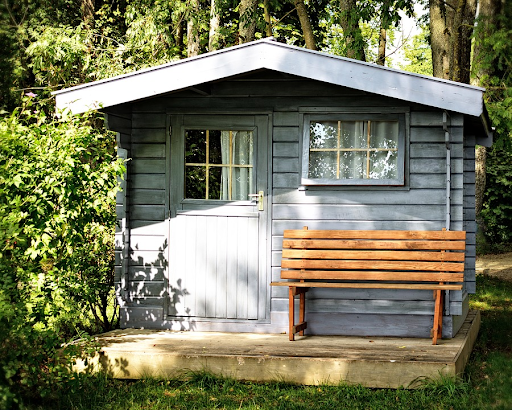
We Brits love our garden sheds. The garden shed has grown from a simple storage to a home addition, often used as an office, granny annexe, or workshop. But using our shed year-round can be a challenge when the cold winter weather rolls in. The solution involves insulating your garden shed, but many homeowners baulk at spending large sums of money on their shed. It’s especially essential for models made of different materials – for instance, a metal shed should be insulated to reduce the risk of condensation.
Insulation projects can grow in cost quickly. But never fear, when it comes to using your garden shed year-round, you can do it for free. All it takes is a bit of hard work, a few everyday materials, and ingenuity.
Key Insulation Points In A Shed
Before attempting to insulate the shed, you should understand where you need to insulate.
- The Floor
Floors, especially those of sheds without a concrete foundation, are prone to heat loss. You’ll want to plan on adding at least one layer of insulation to this area.
- The Walls
Wind and rain love coming in through the walls of a garden shed. When it comes to keeping the shed warm, having several layers of insulation in the walls is a must.
- The Ceiling
Heat rises, and naturally, an uninsulated ceiling will have plenty of heat escaping. Insulating the roof or ceiling is essential to keeping your garden shed warm throughout the year.
Critical Steps For Successful Insulation
Before insulating your shed, follow these steps to ensure a working (and warm) layer of insulation:
- Locate gaps in the wall. The crevices and cracks of the shed may have areas of poor sealing. Take a candle or a lighter and walk around the walls of your shed on a windy day. If the flame wavers near a point in the wall, that area likely needs more sealing before insulation.
- Check for moisture problems. Most free or inexpensive insulation sources aren’t waterproof. Ensure that any leaking areas have a layer of plastic or waterproofing before adding insulation.
- Verify measurements. Insulation reduces the height and width of the shed. If you plan to add several layers of insulation to your annexe, ensure that you know your desired depth and how it will impact your shed’s measurements. Adjust your insulation amounts accordingly. For example, you may need to reduce your insulation if the ceiling threshold drastically reduces.
- Gather safety supplies. Whenever you work with insulation, nails, tools, or other handiwork equipment, wear a pair of safety glasses, filtering mask, and work gloves to protect yourself from chemicals and debris stirred up during the project.
Once you have adequately prepared yourself for the installation, you can begin looking for the proper materials to insulate your shed.
Recycled Insulation Products
-
Styrofoam – Walls and Ceiling
Styrofoam is one of the best products to use for inexpensive insulation. You’ll often find it used to keep refrigerated materials or packages cold, but it works just as well for keeping an outdoor shed warm. Reuse styrofoam received in shipping materials to help insulate the shed. Simply apply sheets of foam to the walls of the shed using glue or tape for application and a utility knife to achieve the desired size for the wall or ceiling in question.
-
Cardboard – Walls and Ceiling
Those old shipping boxes bunched up in the shed can do more than take up storage space. Cardboard has poor thermal conduction, making it optimal for cheap insulation. Simply flatten the boxes to create cardboard sheets, and carefully stack them together into a thick layer of insulation. Slide the cardboard sheets between the walls or roof of the shed if accessible; if not, fix the sheets to the interior walls of the shed using glue or tape. Cardboard is prone to water damage, therefore, waterproofing the walls first is a must.
-
Bubble Wrap – Walls or Ceiling
Bubble wrap works wonderfully as an inexpensive, temporary insulation source for a shed. The air bubbles do lose volume over time, so you’ll need to replace them every few months or so. But, applying bubble wrap as an insulate takes only a few hours – just slide the wrap between the walls of the shed into a dense layer of overlapping wrap. For the ceiling, use double-sided tape or glue to adhere the bubble wrap to the surface.
-
Plastic (Stretch Wrap) – Windows
If windows make waterproofing the shed difficult, go to the kitchen and grab the plastic stretch wrap. Apply a layer or two of the plastic to cover the windows. This helps keep water and cold air out of the cracks in the window.
-
Rugs and Blankets – Floors
The floors of a shed can quickly insulate with the addition of a rug or blanket. Consider lining the floor with plastic before placing the rug down to help prevent water damage.
All Natural Insulation Products
Nature enthusiasts and all-natural product users can insulate their shed with products found on the farm or in the countryside:
-
Mud or Clay – Roof and Exterior Walls; Interior Floor and Walls
For thousands of years, humans have insulated their homes with mud and clay. You can apply a mixture of mud and clay with a paintbrush to the roof and exterior or interior walls and floor of the shed to achieve an insulating, wind-proof layer. However, mud deteriorates over time and is not waterproof, so expect some reapplication needs in the future.
-
Thatching – Roof and Walls
The English countryside is still home to plenty of thatched roofs, and for good reason: they insulate well. You can gather hay or long grass bundled for thatching and layer the material onto the roof or inside the walls of the shed for insulation. However, hay will rot when exposed to water, so expect replacements annually, and waterproof the walls as best you can before using thatching.
-
Wool – Ceiling and Walls
Sheep stay comfortable no matter the season thanks to their wool. If you have access to sheeps wool, you can line the ceiling and walls of the shed with the material. Just stuff the wool into the walls, or gather it into bundles and tape them to the ceiling for additional warmth in the shed.
Inexpensive Insulation Upgrades
If you can spend a few pounds to upgrade your insulation, there are a few items that would significantly improve the use of the above mentioned free insulation materials. These insulation upgrades work well along, too.
-
Liquid Yarn
Liquid yarn can help close the gaps in shed walls that allow water and cold wind into the space. Apply liquid yarn before sealing the walls, ceiling, or floor with stretch wrap to create a better waterproofed area. Additionally, you can utilize liquid yarn around the window and door frames to prevent water from entering those areas.
-
Hardening Foam
Hardening foam is an expanding sealant that works exceptionally well for sealing windows, door frames, and cracks. The foam hardens into a waterproof layer, and most variations are UV resistant as well. Simply spray the foam on the targeted area and let it harden before adding additional insulation.
-
Reflective Insulation
Reflective insulation serves as a radiant barrier and a vapour barrier in one product. It can easily slide between the walls of the shed and work with additional insulation to keep the space cool in the summer and warm during the winter. You can also staple or tape it to the ceiling for additional protection against temperature variation.
-
Fiberglass Insulation
Rolls of fibreglass insulation are relatively inexpensive if you select a lower R-value (insulation ability) product. A roll or two will suffice to fill the walls of the smaller shed with insulation, and usually will only cost about a hundred pounds.
Insulating your home’s garden shed or summer house is a worthwhile project. Simply follow some of these DIY approaches for an inexpensive way to keep your shed comfortable year-round.


